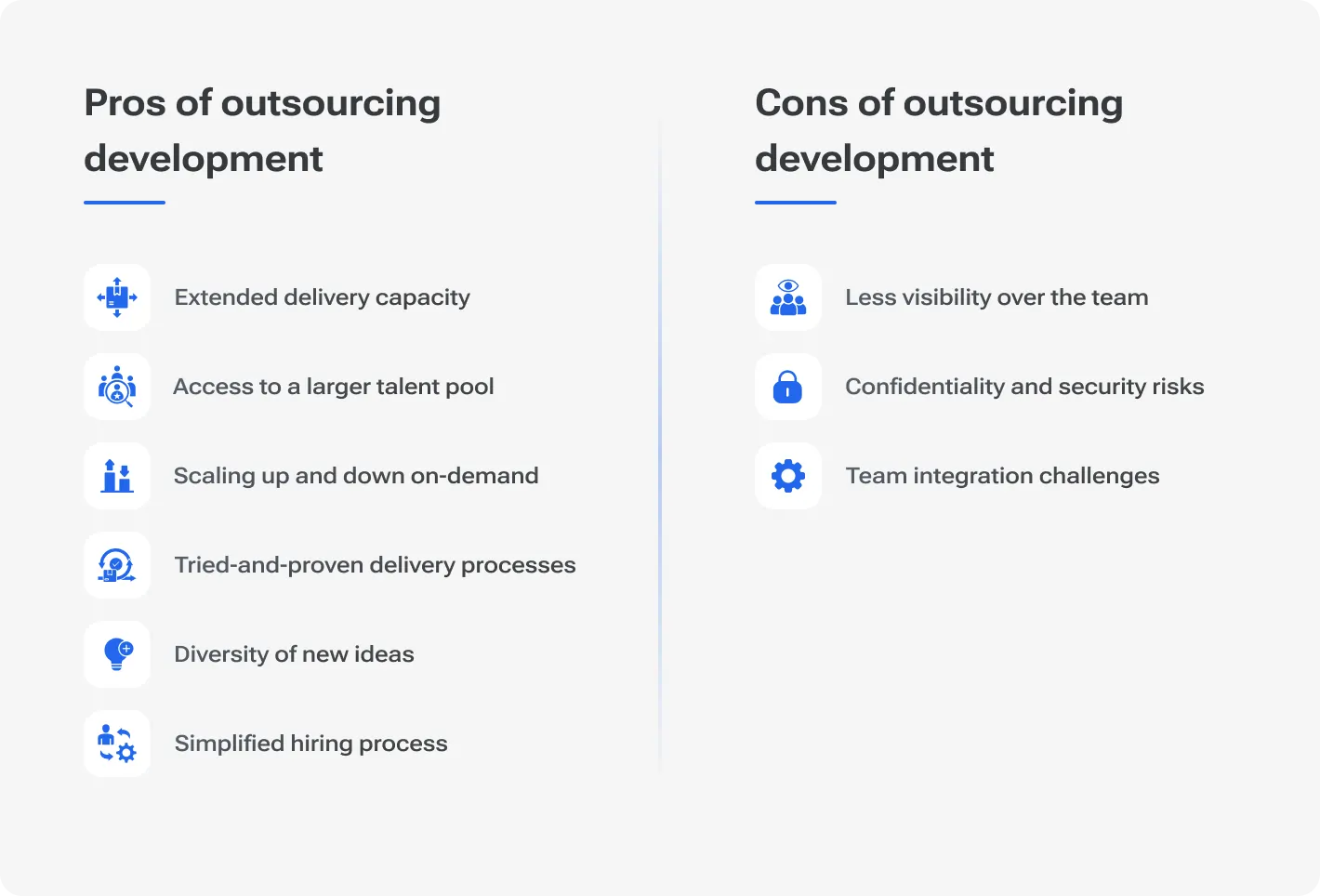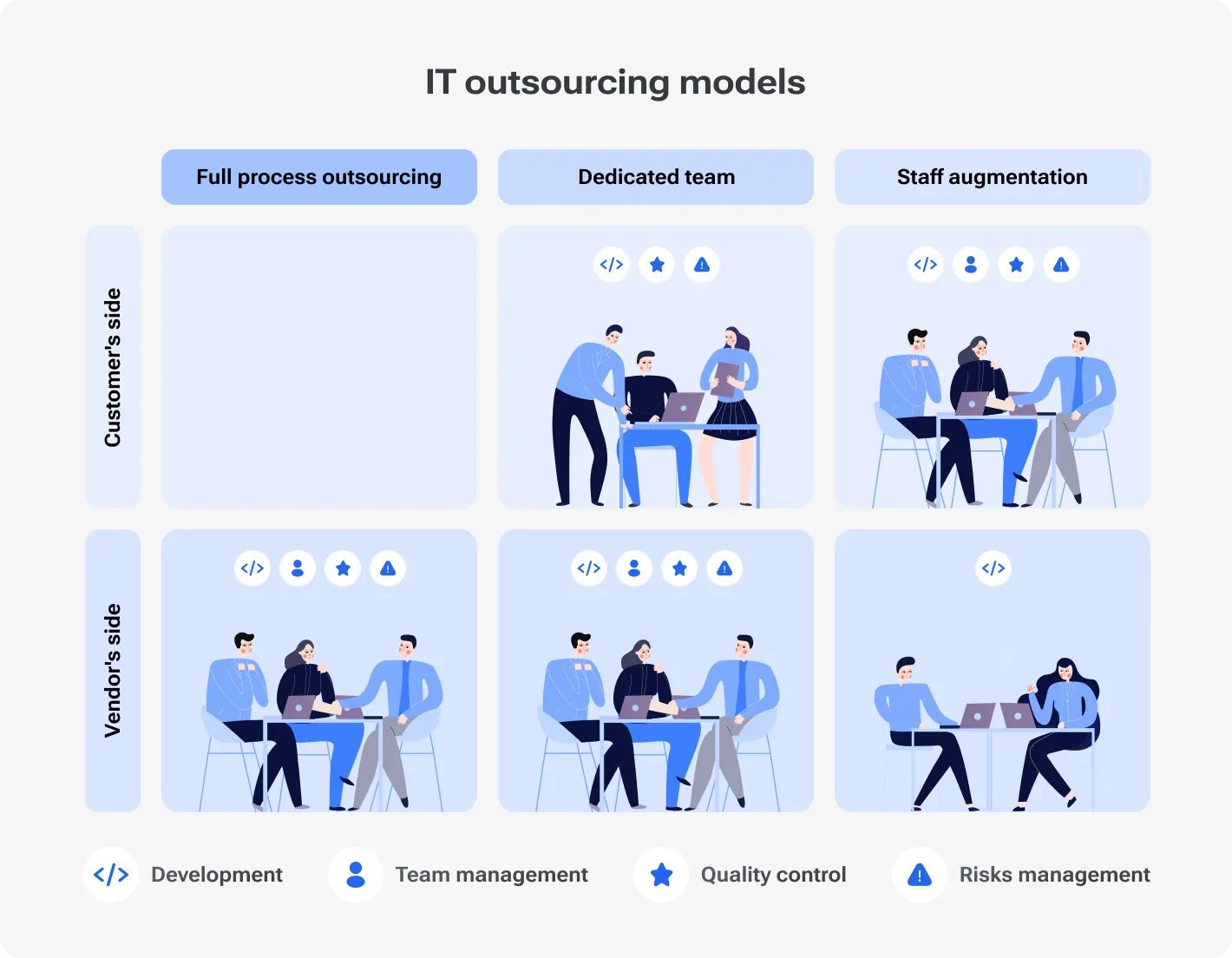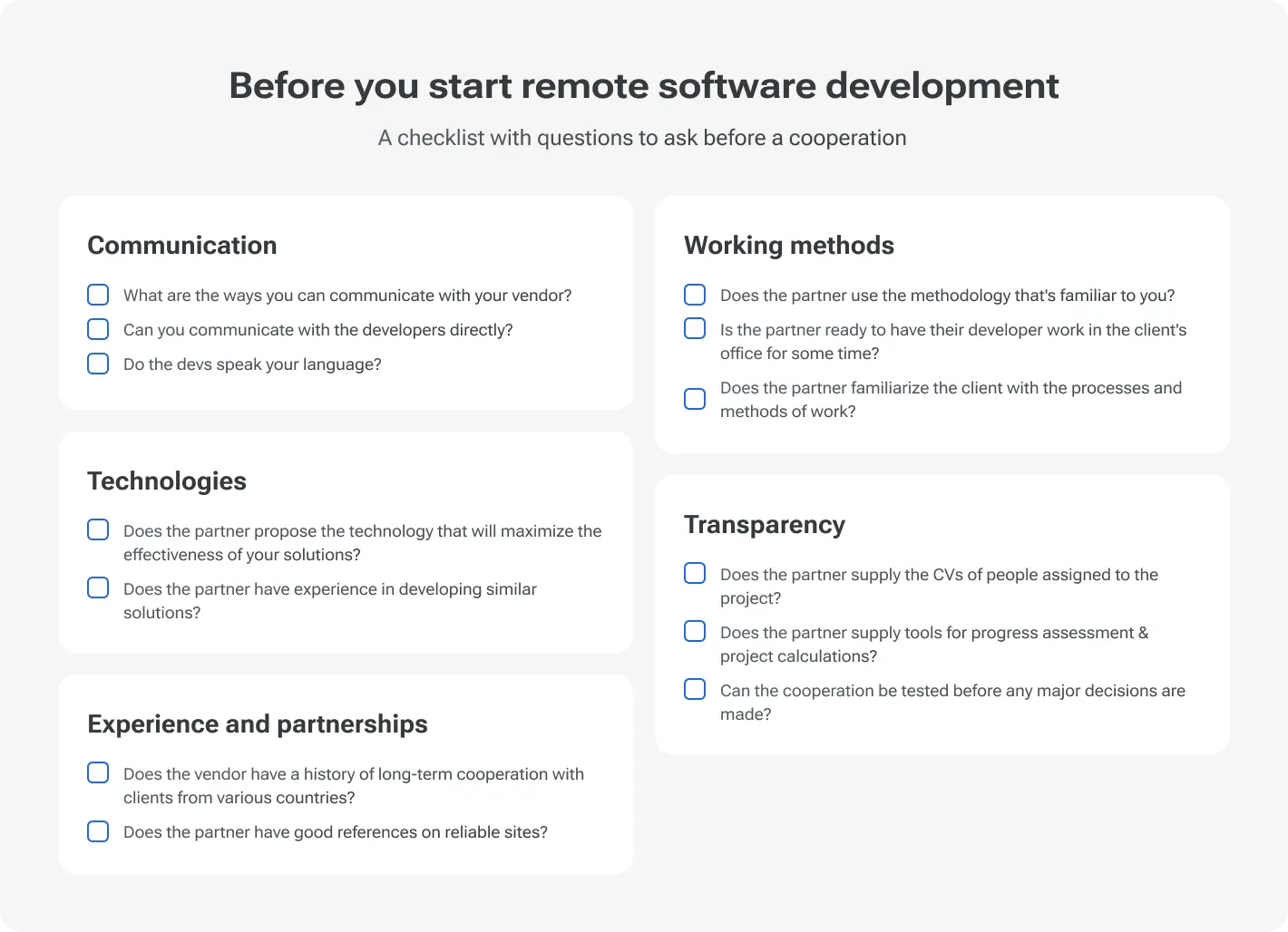Companies face intense competition and ever‐rising pressure to innovate quickly. A recent study published in the Journal of Management Information Systems found that nearly 55% of IT projects experience significant budget overruns because internal teams simply cannot keep up with the pace of change. Strategic external collaboration offers a competitive edge by tapping into specialized expertise. As budgets tighten and market dynamics evolve, making smart outsourcing software decisions is more critical than ever.
This guides CEOs through the key factors that influence software development outsourcing in 2025. We will cover a range of aspects, from understanding the ins and outs of software outsourcing to the right way of selecting outsourcing software development companies.
Flexible staff augmentation and expertise transitioning services
Software development outsourcing 101. What is it, and where does it come from?
Software development outsourcing is delegating software application development, maintenance, or support to an external provider. The approach allows companies to tap into
reduce operational costs;
concentrate on their core business functions.
Software development outsourcing projects can be as small as contracting out specific modules or as large as handing over entire software development projects, offering flexibility and scalability that is hard to achieve in-house.
The from-the-top-of-the-head benefits of outsourcing software development include:
Access to specialized talent. Gain expertise from professionals around the globe.
Faster delivery times. Accelerate project timelines with dedicated external teams.
Cost reduction. Lower expenses by avoiding the overhead of full-time hires.
Scalability. Easily adjust team size according to project needs.
Flexibility. Adapt to changing market conditions with agile external resources.
Understanding how to outsource software development helps businesses see the ways in which strategic partnerships can drive innovation, reduce the burden on internal teams, and lead to more efficient project execution. Now that we have dealt with "whats", it is time to proceed to "whys". Even when you know all about outsourcing software, you still might wonder why you need it in the first place.
Why should CEOs consider software development outsourcing?
For many CEOs and company owners out there, custom software development outsourcing is more than a measure to save money. Done correctly, it can serve as a strategic tool that can turn outsourcing into a long-term positive value. Leaders increasingly partner with external teams to access scarce specialized skills, accelerate innovation, and drive competitive growth. The strategic benefits of outsourcing are multi-faceted and far-reaching.
Reason #1. Broader access to global talent and niche experts
Software development project outsourcing opens the door to a world of specialized expertise that might be difficult or prohibitively expensive to develop in-house. CEOs appreciate that by partnering with external providers. They can tap into talent globally without the limitations of local labor markets. In fact, a Deloitte Global Outsourcing Survey found that 76% of companies outsource IT functions specifically to access specialized skills and global talent.
Many companies report — accessing global talents with software development outsourcing elevates the quality of their projects and introduces fresh perspectives and innovative ideas that drive breakthrough solutions. For example, a company might engage a team of AI specialists from a region known for most innovative AI solutions, think South Korea or Japan, while simultaneously integrating their work with an in-house team focused on core business strategy. The blended model fosters creativity, reduces time spent on training, and accelerates project delivery.
By outsourcing software development, CEOs and company owners gain access to diverse skills and global expertise. As a result, having broader access to skill, talent, and workforce empowers them to overcome local talent shortages and achieve superior project outcomes.
Reason #2. Faster time-to-market
When it comes to competing with other businesses on the market, speed is essential. Software development outsourcing models help companies dramatically reduce the time required to develop and launch new products. With external teams dedicated to specific tasks or projects, organizations can bypass lengthy recruitment cycles and ramp up development quickly. The acceleration is particularly beneficial for startups and technology firms. In their situation, every day counts in capturing market share.
The evidence indicates that software development outsourcing can reduce development time by up to 30%. As a result, companies can launch products faster.
Reason #3. Freeing up internal resources
One of the most compelling reasons for software development outsourcing is the ability to offload non-core activities. Such an approach allows internal teams to concentrate on strategic initiatives. When routine development tasks or specialized projects are handled externally, in-house teams can focus on innovation, strategy, and customer engagement. The reallocation of resources leads to improved productivity. Besides, it means you can make better use of your internal talent. According to this survey, 65% of companies said they outsource non-core IT functions so their internal teams could focus on driving growth.
By outsourcing software development work, CEOs can shift their focus away from day-to-day routine challenges. Instead, they can dedicate more time to driving business growth. For instance, rather than investing heavily in recruiting and training full-time developers, a company might outsource its software development, allowing its core team to work on strategic planning and market expansion.
Outsourcing non-core functions empowers internal teams to drive strategic growth. When investing more time and effort on strategic objectives, CEOs and company owners will definitely see the rise of ROI and revenue. The best part is that while you have the increase in ROI, your miscellaneous tasks are taken care of as well.
Reason #4. Fast scaling to match the market demands and expand development resources if needed
The ability to scale quickly is a significant advantage of outsourcing software. With market morphing, your project requirements change as well. In most cases, companies and businesses will face certain periods where they need to rapidly expand development resources. These changes often happen abruptly and without prior consideration. In such a case, software development outsourcing is the way to stay flexible, with a chance to quickly respond to abrupt changes by adding or reducing team members. In a Deloitte survey, 42% of CTOs reported that outsourcing is essential for quickly scaling their development teams to meet changing demands.
With the right outsourcing software development partner, the so-needed expansion can be achieved fast. Conversely, when demand subsides, the external team can be scaled down accordingly. The elasticity is especially valuable in an unpredictable market where demand can fluctuate rapidly.
Reason #5. Effective risk management and mitigation of talent shortages and high employee turnover phases
Outsourcing development is critical in risk management. It provides a buffer against internal resource constraints and talent shortages. When you face a period of high turnover, you can use the power of external teams. Respectively, this helps reduce the adverse impact of unexpected staff turnover or skill gap. With software development outsourcing, you can fill in the gaps fast, without derailing the project. A Deloitte Global Outsourcing Survey found that 56% of companies reported improved risk management and talent stability through outsourcing, effectively mitigating the impact of high employee turnover.
In addition, external partners often deliver their solutions and services along with risk management processes. In most cases, software development outsourcing companies use Agile methodologies. The method brings iterative development to the table. It helps deconstruct more complex projects into manageable aspects.
Key market trends in software development outsourcing
Recent studies provide a clear picture of how rapidly this market is expanding. Global software development outsourcing is projected to grow 9.8% annually, reaching nearly $560 billion by the end of 2025. A Statista survey from early 2024 reveals that 68% of companies plan to expand their reliance on outsourced teams.
The market trends moving the outsourcing software market further:
-
Many organizations now see outsourcing as a cost-saving measure and a way to drive innovation. When companies and businesses saw in practice how outsourcing could save costs, the growing number of firms started appealing to it.
-
Emerging trends in technology are also influencing the outsourcing software market. The full-on integration of AI, ML, and RPRa takes automation to the next level.
-
Increased regulatory pressure and data protection standards have pushed the market to new heights. The segment becomes more safe and more secure when regulatory bodies catch up with new technologies and approaches.
A deeper understanding of the market trends above is a great starting point for seeing where the entire outsourcing software development market is moving at the moment. The next important thing is to get a closer look at software outsourcing as it is. To know how to use it properly, it is crucial to know what it is all about first.
The most common outsourcing software development models
Software development project outsourcing can be structured in various ways. Based on the approach, every model comes with its unique cost structures and operational benefits. The right engagement model depends on three key factors, namely:
-
project’s complexity;
-
the degree of flexibility needed;
-
long-term business goals.
Understanding these helps in selecting the best approach to align with your project requirements and budget constraints. Keep in mind, the right model selected from the start is one of the important aspects on how to successfully outsource software development.
Full process outsourcing
The fixed-price model is ideal for projects with transparent requirements and clear timelines. With a fixed-price model, the vendor agrees to deliver a complete solution for a set price. It is exactly what the name “fixed-price” indicates. As a result, you get cost predictability, which means your budgeting will be way simpler to do.
With fixed pricing, you know the total investment upfront. No more budget overruns on the horizon. Keep in mind that the model can be less flexible if project requirements change mid-course.
Ideal for: Fixed-price works best when the project scope and deliverables are crystal clear.
Staff augmentation
The time & materials model charges are based on the hours worked. Staff augmentation approach is more flexible, accommodating evolving requirements and iterative development. It is beneficial when project needs are uncertain or when you anticipate frequent changes. However, because costs vary with time and effort, you need to closely monitor everything to keep the overall budget in check.
Ideal for: Time & materials offer adaptability and iterative improvements. Yet, keep in mind that this model demands active oversight to control costs effectively.
Dedicated team model
The dedicated team model is about hiring an external team, often from a global talent pool, to work exclusively on your project over a short or long period of time. The model is perfect for long-term or large-scale projects. These require ongoing 24/7 support and integration with your internal operations. Though the hourly rates might be higher than other models, the dedicated model offers consistent expertise. The dedicated software development team model enables you to scale resources up or down according to your needs. The best part is that doing the scaling does not mean you need to stop the steady workflow.
Ideal for: The model is optimal for projects that need long-term engagement. Besides, it is great for projects relying on deep collaboration.
When it comes to evaluating the above mentioned software development outsourcing models, you need to choose the one that best fits your project scope and strategic objectives. Remember that each model comes with both pros and cons. The key thing for you is to understand whether the benefits outweigh the trade-offs. A well-informed decision is the one balancing costs and quality.
Developing your software development outsourcing strategy. 3 key considerations for CEOs and company owners
A well-planned outsourcing strategy begins with clearly understanding your company’s needs and objectives. This involves defining project requirements, setting measurable performance indicators, and establishing realistic budgets and timelines. CEOs must take a structured approach to map out these details before evaluating potential vendors.
10 questions to ask your software development outsourcing vendor
Consideration #1. Clearly defining your needs and objectives via detailed planning with measurable outcomes
Before engaging with an external vendor, identify your specific software development requirements. Are you looking for full-scale development, maintenance support, or augmentation of your existing team? Clearly define your project scope, expected deliverables, and timelines. Besides, establish key performance indicators (KPIs) to help you track progress and measure success throughout the engagement.
Pro tips:
invest ample time upfront to define requirements;
outline your budget and timeline constraints.
Consideration #2. Choosing the right partner for the best outsourcing software development cooperation
Selecting a partner with the right technical expertise, industry experience, and a cultural fit with your organization. Evaluate potential vendors by reviewing portfolios, case studies, and client testimonials. If possible, conduct interviews and ask for references to confirm that they have successfully handled projects similar to yours. Remember, transparent communication and a track record of reliable performance are non-negotiable.
Pro tips:
use a structured evaluation process;
review portfolios and case studies;
conduct interviews and confirm the vendor’s fit.
Consideration #3. Taking care of legal considerations from the get-go
Protecting your intellectual property is essential for a software development outsourcing agreement. Contracts should include clear
-
service level agreements (SLAs);
-
confidentiality clauses;
-
intellectual property ownership rights.
Key points include ensuring that all parties sign NDAs and that the contract details expectations, deliverables, and penalties for non-compliance. Top staff augmentation vendors usually provide their clients with full ownership rights for their intellectual property from day one. A well-drafted contract safeguards your interests and minimizes risks throughout the project lifecycle.
Pro tip:
Focus on robust contractual agreements that cover IP rights, security, and dispute resolution.
Develop sound legal and contractual frameworks.
Keeping all the above aspects in mind, one thing is clear, the key to the right software development outsourcing stems from clear objectives, the right partner at your side, and legal considerations taken care of. In the triad we mentioned, finding the right vendor might be the most challenging one. That is why the next section provides in-depth insights into finding the best among outsourcing software development companies and retaining the best possible relationships.
Flexible trials for staff augmentation and expertise transitioning services
Managing the outsourcing software development relationship for long-lasting success
Once you’ve selected a vendor, managing the ongoing relationship is key to achieving project success. A strong partnership relies on clear expectations, effective communication, and regular performance monitoring. Here are some essential strategies to help you build and sustain a successful outsourcing relationship.
Once you’ve found the right vendor for your project, the next important thing is to create a long-lasting relationship that will result in a win-win for everyone involved. A strong outsourcing software partnership is all about three key things: clear expectations, effective communication, and transparent performance monitoring.
How to integrate outsourced developers into in-house teams
Step 1. Set clear expectations and communication protocols to make sure processes are smooth and there are no misunderstandings
Begin by establishing regular communication channels and setting a schedule for updates.
Start to define roles and responsibilities for internal teams and the outsourcing partner. Agree on the tools and methods for tracking progress. Ask the vendor to explain their communication setup, update frequency, and how they manage project coordination. These insights will give you a clearer picture on how the software outsourcing vendor communicates and manages their teams and strategies.
Additional strategies include:
Document all project requirements in writing.
Create a communication playbook.
Outline escalation paths for issues.
Step 2. Monitoring progress and performance to make sure the project stays on track despite deviations
Tracking key metrics is critical to maintaining project performance.
Use data-driven insights to measure progress against your established benchmarks. For instance, scheduling bi-weekly performance reviews to monitor productivity trends and resource utilization. Establish a regular cadence for performance reviews. Use real-time data to guide decision-making within the entire software development project outsourcing.
Additional measures include:
Implement a project health dashboard.
Set up automated reporting systems.
Regularly comparing current performance against initial project goals.
Step 3. Building a strong partnership and fostering long-lasting success for outsourcing development
Fostering a positive relationship with your outsourcing partner is crucial for long-term success. What constitutes a “strong partnership”? A strong partnership is built on trust, transparency, and mutual respect. Encourage open communication, share knowledge regularly, and celebrate milestones together. Don’t forget to recognize and reward successes to maintain motivation and drive high performance.
For example, quarterly joint strategy sessions will encourage cross-team collaboration. Prioritize building a relationship based on trust and shared objectives, leading to better alignment and long-term success.
Additional strategies to strengthen the partnership include:
Regular stakeholder engagement. Schedule periodic meetings with your internal teams and the vendor to discuss project progress and plans.
Conflict resolution mechanisms. Establish clear protocols for resolving disputes quickly and fairly.
Flexibility in scaling. Agree on procedures for scaling the team up or down based on project demands without causing disruption.
Robust contract management. Regularly review and update contractual terms to reflect evolving project needs and performance expectations.
Motivated and focused experts for up to 60% less than locals, delivered in days, not months
The essential art of mitigating risks, challenges, and bottlenecks
While outsourcing development offers many benefits, it carries its own risks. Proactively addressing potential pitfalls is key to maintaining project integrity and controlling costs.
Some most common pitfalls to avoid when outsourcing software development
Outsourcing software projects can be highly effective. However, there are some risks involved. If not addressed early, the pitfalls can derail a project and lead to significant delays. Identifying these challenges upfront allows you to implement strategies to mitigate them.
The 8 key pitfalls to watch out for:
-
Miscommunication. Inconsistent or unclear communication can result in misunderstandings and misaligned expectations between your team and the vendor.
-
Vague requirements. Inadequate or poorly defined project specifications can lead to scope creep and frequent rework.
-
Cultural differences. Diverse work cultures may cause friction, affecting team cohesion and collaboration.
-
Time zone challenges. Significant differences in working hours can delay responses and slow project progress.
-
Quality control issues. Inconsistent quality standards can lead to subpar deliverables, requiring costly fixes later.
-
Security breaches. Insufficient data protection measures increase the risk of security incidents that could compromise sensitive information.
-
Misaligned expectations. Your vendor might not meet your strategic objectives without clear benchmarks and regular feedback.
-
Inadequate risk management. Failing to plan for potential risks can result in unforeseen challenges and budget overruns.
7 mistakes to avoid in outsourcing software development
The bright future of software development outsourcing models
As technology evolves, the outsourcing landscape will adapt to meet new demands. Emerging trends such as Agile development, cloud computing, AI, and automation are reshaping outsourcing approaches.
Agile and hybrid engagement models
Agile development continues to reshape project delivery by emphasizing iterative progress and continuous feedback. Many organizations are moving toward hybrid models that blend in-house oversight with external teams. This combination allows companies to maintain strategic control while rapidly accessing specialized skills when needed. Studies show that companies using Agile outsourcing report up to a 20% increase in productivity compared to traditional models.
Why agile and outsourcing is better together
Using the power of emerging technologies
Emerging technologies like artificial intelligence, machine learning, and advanced automation are transforming software development outsourcing. AI-driven tools help reduce manual coding errors and speed up development cycles, cutting overall costs significantly. A recent report predicts that AI integration in IT operations will boost productivity by an estimated 15-20% by 2025.
Some vendors already use automated testing, predictive analytics, and code optimization tools to streamline processes and deliver higher-quality products faster. Early adopters can expect improved efficiency and lower outsourcing prices as these technologies mature.
The new perspective on sustainability and ethical outsourcing
Sustainability and ethical practices are gaining prominence in vendor selection. Companies are increasingly required to consider their outsourcing choices' environmental and social impact. A Deloitte survey found that nearly 60% of businesses now factor sustainability into their vendor decisions. Vendors that commit to ethical labor practices and sustainable operations often deliver higher quality services while mitigating reputational risks.
Organizations are now asking potential partners to provide evidence of sustainable practices, such as carbon footprint reduction and adherence to fair labor standards. This shift aligns with global consumer expectations and meets tightening regulatory requirements.
The impact of remote work normalization
The normalization of remote work has fundamentally altered the outsourcing landscape. With remote work now mainstream, communication and collaboration across borders have become more efficient. A recent survey by McKinsey reported that 70% of IT decision-makers plan to maintain remote work policies permanently. This shift has decreased vendor overhead costs, making software development outsourcing more attractive and competitive.
Unlocking the potential of software outsourcing
A well-planned software development outsourcing strategy can be a game changer in today's competitive landscape. Companies that combine a clear understanding of market dynamics with a structured approach to vendor selection and project management unlock significant value.
Ready to unlock the full potential of external talent and drive innovation in your software projects?
Contact us today to explore how our tailored outsourcing solutions can help you achieve your business goals with a clear, data-driven strategy and a commitment to quality.
End-to-end solutions with predictable budgets, a time-to-market advantage with up to 50% budget savings






